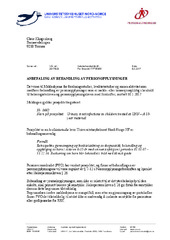| dc.description.abstract | Background and objective: Urinary tract infections (UTI) are common in children and can be hard to diagnose early. They range from benign to life threatening conditions, sometimes requiring prompt treatment. The objective of this paper is to register the basic information and the signs, symptoms and risk factors of children with UTIs, what diagnostics were performed, their results and what treatment and follow-up they were given.
Material and methods: A retrospective study was conducted using data available from the University Hospital of North Norwaty (UNN) departments of Tromsø, Harstad and Narvik. The data was collected in the summer of 2017, going through medical records from 01.01.2007-31.12.2016. The relevant data related to the paper was anonymized and subsequently categorized in an SPSS file. The study was approved as a quality study by the representative of the Institutional review Board (Personvernombudet) at UNN, Per Bruvold.
Results: Of 396 patients in the hospital’s records, 133 had a confirmed febrile urinary tract infection. Mean age was 3.3 years, 68.4% of the patients were female. The single most common presenting symptom was fever 45/133 (33.8%), especially in children <2 years of age where it was 35/82 (42.7%). The prevalence of any structural genitourinary abnormality was 57/133 (42.9%). Of 125 urine samples cultured, 97/125 (72.9%) were positive. E.coli was the most common pathogen 74/97 (76.3%). Blood culture was sampled in 109/133 (82.0%), the prevalence of bacteremia was 11/109 (10.1%).
Conclusion: This study has shown that the gender and age distribution was in accordance to available literature. Dipstick analyses were performed in 97.7% and the urine cultured in 94.0% of the cases. The signs, symptoms and risk factors differed significantly (P<0.05) based on the factors of age, gender, pathogens and CRP-values. Risk factors were associated with higher age, male gender, non-E.coli and higher CRP-values. There were 72.9% cases of significant bacteruria and 10.2% cases of significant bacteremia. E.coli was the most prevalent pathogen found, representing 76.3 % of urine isolates and 63.6% of the blood cultures. Ultrasound was performed in 110 patients and MCUG in only 18. Abnormal genitourinal findings had a prevalence of 57/133 (42.9%), and VUR was found in 15/133 (11.3%). Antibiotics were given to 131/133 (98.5%) of the patients, of which empirical treatment followed Norwegian guideline standards in 114/126 (90.5%) of the cases. Ampicillin-Gentamicin IV was the most commonly used antibiotic in both the empirical (85.7%) and during the admission (47.7%). | en_US |


 English
English norsk
norsk

